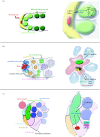Evolution and spermatogenesis
- PMID: 20403864
- PMCID: PMC2871925
- DOI: 10.1098/rstb.2009.0323
Evolution and spermatogenesis
Abstract
Sexual reproduction depends on the production of haploid gametes, and their fusion to form diploid zygotes. Here, we discuss sperm production and function in a molecular and functional evolutionary context, drawing predominantly from studies in model organisms (mice, Drosophila, Caenorhabditis elegans). We consider the mechanisms involved in establishing and maintaining a germline stem cell population in testes, as well as the factors that regulate their contribution to the pool of differentiating cells. These processes involve considerable interaction between the germline and the soma, and we focus on regulatory signalling events in a variety of organisms. The male germline has a unique transcriptional profile, including expression of many testis-specific genes. The evolutionary pressures associated with gene duplication and acquisition of testis function are discussed in the context of genome organization and transcriptional regulation. Post-meiotic differentiation of spermatids involves very dramatic changes in cell shape and acquisition of highly specialized features. We discuss the variety of sperm motility mechanisms and how various reproductive strategies are associated with the diversity of sperm forms found in animals.
Figures

Similar articles
-
Sperm competition and the evolution of spermatogenesis.Mol Hum Reprod. 2014 Dec;20(12):1169-79. doi: 10.1093/molehr/gau070. Epub 2014 Oct 16. Mol Hum Reprod. 2014. PMID: 25323971 Review.
-
Functional significance of the sex chromosomes during spermatogenesis.Reproduction. 2015 Jun;149(6):R265-77. doi: 10.1530/REP-14-0613. Reproduction. 2015. PMID: 25948089 Free PMC article. Review.
-
Molecular mechanisms involved in the differentiation of spermatogenic stem cells.Rev Reprod. 2000 May;5(2):93-8. doi: 10.1530/ror.0.0050093. Rev Reprod. 2000. PMID: 10864853 Review.
-
Prothymosin alpha expression and localization during the spermatogenesis of Danio rerio.Zygote. 2016 Aug;24(4):583-93. doi: 10.1017/S0967199415000568. Epub 2015 Oct 9. Zygote. 2016. PMID: 26450176
-
Spermatogenesis.Curr Biol. 2017 Sep 25;27(18):R988-R994. doi: 10.1016/j.cub.2017.07.067. Curr Biol. 2017. PMID: 28950090
Cited by
-
Peroxisome proliferator-activated receptor gamma signaling in human sperm physiology.Asian J Androl. 2015 Nov-Dec;17(6):942-7. doi: 10.4103/1008-682X.150253. Asian J Androl. 2015. PMID: 25851655 Free PMC article. Review.
-
Developmental RNA-Seq transcriptomics of haploid germ cells and spermatozoa uncovers novel pathways associated with teleost spermiogenesis.Sci Rep. 2022 Aug 19;12(1):14162. doi: 10.1038/s41598-022-18422-2. Sci Rep. 2022. PMID: 35986060 Free PMC article.
-
Dichotomous transcriptome divergence at the cell-type level between the Drosophila male and female germlines.bioRxiv [Preprint]. 2025 Jul 8:2025.07.04.663238. doi: 10.1101/2025.07.04.663238. bioRxiv. 2025. PMID: 40672326 Free PMC article. Preprint.
-
KIFC1-like motor protein associates with the cephalopod manchette and participates in sperm nuclear morphogenesis in Octopus tankahkeei.PLoS One. 2010 Dec 20;5(12):e15616. doi: 10.1371/journal.pone.0015616. PLoS One. 2010. PMID: 21187923 Free PMC article.
-
Wdr17 Regulates Cell Proliferation, Cell Cycle Progression and Apoptosis in Mouse Spermatocyte Cell Line.Animals (Basel). 2024 May 9;14(10):1418. doi: 10.3390/ani14101418. Animals (Basel). 2024. PMID: 38791636 Free PMC article.
References
-
- Aguinaldo A., Turbeville J., Linford L., Rivera M., Garey J., Raff R., Lake J.1997Evidence for a clade of nematodes, arthropods and other moulting animals. Nature 387, 489–493 (doi:10.1038/387489a0) - DOI - PubMed
-
- Anderson M., Dixson A.2002Sperm competition: motility and the midpiece in primates. Nature 2002, 496 (doi:10.1038/416496a) - DOI - PubMed
-
- Anderson R., Copeland T. K., Scholer H., Heasman J., Wylie C.2000The onset of germ cell migration in the mouse embryo. Mech. Dev. 91, 61–68 (doi:10.1016/S0925-4773(99)00271-3) - DOI - PubMed
-
- Andrews J., Bouffard G. G., Cheadle C., Lu J. N., Becker K. G., Oliver B.2000Gene discovery using computational and microarray analysis of transcription in the Drosophila melanogaster testis. Gen. Res. 10, 2030–2043 (doi:10.1101/gr.10.12.2030) - DOI - PMC - PubMed
-
- Arbouzova N. I., Zeidler M. P.2006JAK/STAT signalling in Drosophila: insights into conserved regulatory and cellular functions. Development 133, 2605–2616 (doi:10.1242/dev.02411) - DOI - PubMed
MeSH terms
LinkOut - more resources
Full Text Sources
Molecular Biology Databases

